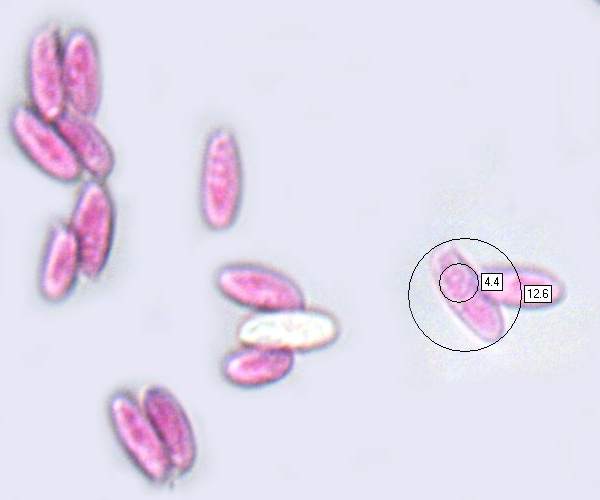Flammulina elastica (Sacc.) Redhead & R.H. Petersen
Phylum: Basidiomycota - Class: Agaricomycetes - Order: Agaricales - Family: Physalacriaceae
Distribution - Taxonomic History- Etymology - Identification - Culinary Notes - Reference Sources
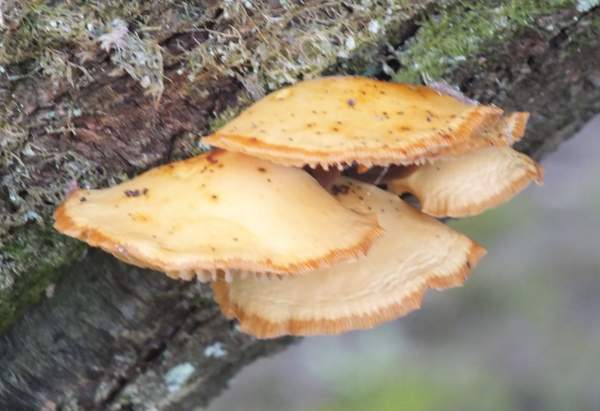
The yellow or pale orange caps of Flammulina elastica can be seen in winter (currently most British records were made in January, February or March). The specimens shown here were photographed on Christmas Day 2016 in north Pembrokeshire, Wales UK - map reference SN 18669 45113.
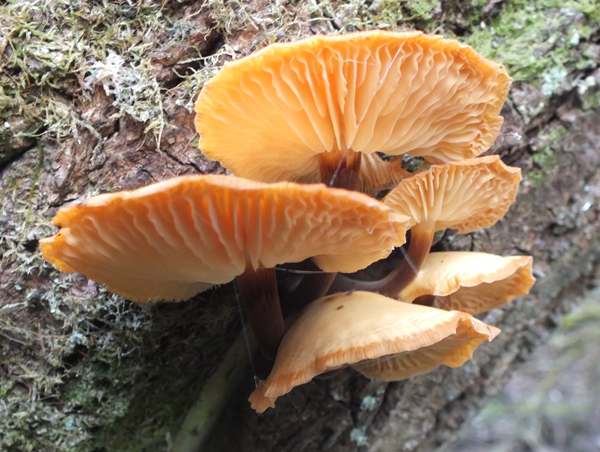
These mushrooms grow mainly in clusters that are sometimes tiered; as a result, the caps are fairly regular but with slightly offset curved stems.
Caps from the closely-related Flammulina velutipes are edible and are grown commercially in Japan, where they are variously known as Enoki, Enokitake or Enoko-take.
Distribution
In Britain, Flammulina elastica is rarely recorded; however, in the past it is likely that this winter mushroom was wrongly recorded as the much more common Flammulina velutipes and so in reality this willow rotter may be rather more common than records currently suggest. (As of December 2016 there are just 10 records in the database of Fungal Records of Britain and Ireland, and only one of those sightings occurred in Wales.)
Taxonomic history
This species was described in 1887 by Italian mycologist Pier Andrea Saccardo, who gave it the scientific name Collybia elastica. The currently-accepted name Flammulina elastica dates from a 1999 publication by Canadian mycologists Scott A. Redhead and American mycologist Ronald H. Petersen (b. 1934).
Synonyms of Flammulina elastica include Agaricus elasticus Lasch, Collybia elastica Sacc., and Flammulina velutipes f. longispora Bas.
Etymology
The generic name Flammulina is a reference to the yellow or orange caps, which shine like 'little flames' in the winter sunshine. This mushroom's specific epithet elastica refers to the flexible texture of these mushrooms.
Identification Guide
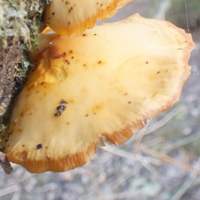 |
Cap2 to 10cm across, the yellowish caps of Flammulina elastica are initially convex, often flattening as they become mature. The cap margin is often slightly wavy. Slimy in wet weather, the caps dry to a smooth sheen. |
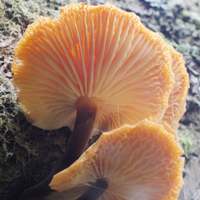 |
GillsAdnate to emarginate and broad, the moderately-spaced gills are creamy white at first becoming pale yellow as the fruitbody matures. StemThe stem is tough and covered in a fine velvety down. Usually pale creamy yellow near the cap, the stems often turn brown towards the base. |
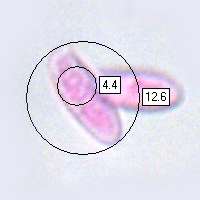 |
SporesEllipsoidal, smooth, 8-12 x 3-4µm; inamyloid. Spore printWhite. |
Odour/taste |
Not distinctive. |
Habitat & Ecological role |
Saprobic on trunks of diseased willows and occasionally poplars. |
Similar species |
Velvet Shank Flammulina velutipes usually has a darker orange cap and its spores are significantly smallerand with a lower Q value (length to width ratio) than those of Flammulina elastica. Kuehneromyces mutabilis, the Sheathed Woodtuft or Brown Stew Fungus, has a darker orange cap, much darker gills, and brown spores. |
Culinary Notes
Because of its rarity, Flammulina elastica is not sought by foragers; however, its very close relative Flammulina velutipes is known to be edible.
Reference Sources
Fascinated by Fungi, 2nd Edition, Pat O'Reilly 2016, reprinted by Coch-y-bonddu Books in 2022.
Dictionary of the Fungi; Paul M. Kirk, Paul F. Cannon, David W. Minter and J. A. Stalpers; CABI, 2008
Taxonomic history and synonym information on these pages is drawn from many sources but in particular from the British Mycological Society's GB Checklist of Fungi.
Fascinated by Fungi. Back by popular demand, Pat O'Reilly's best-selling 450-page hardback book is available now. The latest second edition was republished with a sparkling new cover design in September 2022 by Coch-y-Bonddu Books. Full details and copies are available from the publisher's online bookshop...
